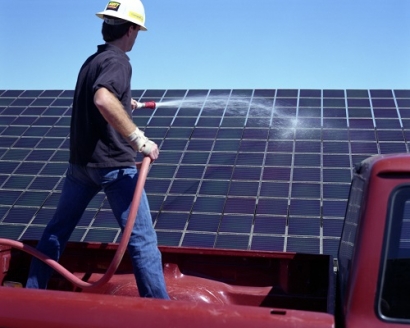
The blackouts left customers scrambling for ways to keep the lights on in the future, with some Californians shelling out as much as $30,000 for home generators.
Other consumers have a different plan and think that home solar energy systems may be the solution.
Solar Systems Can Keep the Lights On
Some homeowners are already installing solar energy systems for the express purpose of keeping their homes electrified through future blackouts.
These systems — like any solar system connected to the grid — won't work when the power is turned off. Instead, they store extra energy that can be used during blackouts on large home batteries or battery systems.
There are other benefits to these systems — including some that may even make wildfires less likely in the future.
Home solar systems can lower the amount of energy being transferred over power lines, which can reduce the chance of grid-sparked wildfires. This is especially true for consumers living on the edges of PG&E's grid, where energy infrastructure tends to be less maintained and more prone to sparking.
Some communities are even discussing the possibility of joining together multiple home and business solar systems to create microgrids — parallel energy systems that can keep areas electrified even when the main grid is down. Business leaders are especially interested in this tech as a way to better prepare business infrastructure — like data centers and warehouses — for wildfires and other natural disasters.
The Challenges of Home Solar Systems
While the possibilities of solar energy are exciting, there are some challenges that prospective solar system operators will have to face.
The biggest is the cost of an effective solar energy-and-battery system. Typical solar batteries hold a charge of around 10 kilowatt-hours, or about one-third of the average household's daily energy use. Three batteries are all you'd need to keep a home running for an entire day — or maybe longer, if you ration your energy use.
That doesn't sound too bad until you see how much these batteries cost — for example, Tesla's 13.5 kWh battery, the Powerwall 2, costs $6,700. Each Powerwall also weighs almost 300 pounds and is nearly four feet tall. Three batteries would cost more than $20,000 on top of the solar system's cost, and would take up around 28 square feet of wall space.
These back-up batteries are also not particularly environmentally friendly, which could be a turn-off for customers who are looking for the most environmentally-friendly solution to their blackout problem.
Also, it's not clear whether or not off-the-grid solar systems are legal under the current California Energy Code. Right now, systems need to have "interconnection with the electrical service," but neither "interconnection" nor "electrical service" are defined all that clearly. While it doesn't seem likely that a judge will rule against one of these systems, no one really knows if a solar system connected to a battery and a non-functional grid counts as "interconnected."
In the future, Californians, and potentially residents of many other states, may need to find a way to keep their homes electrified through planned blackouts. Whether it’s generators or solar + battery systems, residents need to face the challenges of keeping the lights on now so they don’t wind up searching in the dark for answers.
Jenna Tsui is an environmental and tech journalist hailing from Texas. With a degree in IT and a passion for sustainability, she frequently writes about the intersection of the two subjects and loves to discover new environmental tech. She also co-owns The Byte Beat blog and writes for sites like Blue & Green Tomorrow, Green Journal, and Get Green Now. Check out her work on TBB or follow her on Twitter @jenna_tsui .
*Twitter: *https://twitter.com/jenna_tsui
*The Byte Beat:* http://thebytebeat.com/

